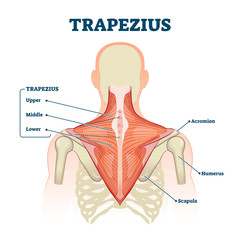Fibromyalgia Basics
Muscle Fatigue, Stiffness & Exercise
Home | Fibro Friendly Exercises

Do you feel like your muscles just don’t have the endurance, strength, or flexibility to get through the day? More than likely, you wake up with widespread stiffness and no matter how much you stretch your tight fibromyalgia muscles, they freeze back up again. Adding to your frustration is the fact that the muscles in fibromyalgia fatigue quicker than they should.
Morning stretches ease your stiffness, but each day starts anew. The moment you open your eyes, you are greeted by a body that is tight as shoe-leather. You probably have a fitness program too, but if you stop it, your body forgets how to move. It’s like fibrofog of the muscles. What could be causing so many roadblocks?
Working Triggers
Most fibromyalgia patients have 10-12 active myofascial trigger points (MTPs).1 Trigger points are regions where the muscle fibers are contracted into knots. They hurt and restrict range of motion, but are they the reason why your fibromyalgia muscles fatigue so easily?
Hong-You Ge, M.D., Ph.D., of Denmark, investigated the relationship between accelerated muscle fatigue and MTPs.2 He used healthy, young subjects with just one mild MTP in the upper trapezius. It’s the triangular muscle on each side that covers your shoulder blades. If a single MTP alters trapezius muscle performance in fit people, it could explain why MTP-loaded fibromyalgia muscles fatigue easily.

Participants performed a sustained contraction of both trapezius muscles by holding their arms straight out (forming a T). One side contained an MTP while the other didn’t. This setup enabled Ge to measure the impact of the trigger point during the contraction.
A tiny needle was inserted into the muscle near the MTP to pick up the electromyographic (EMG) signal throughout the contraction period. As muscles fatigue, the EMG signal dwindles. Ge placed a surface EMG probe one inch away to detect if nearby muscle fibers pitched in during the contraction. He also put muscle and surface EMG probes in the same position on the non-MTP side for comparison.
The pain produced by the contraction was double on the MTP side. In addition, the presence of the MTP caused a dramatic drop in the EMG signal. This means many more fibers were recruited to do the same job.
“We used objective EMG measures in this study to quantify muscle fatigue and showed it occurs four times faster near MTPs,” says Ge. “This suggests that fibromyalgia muscles quickly fatigue due to a large amount of MTPs. Patients are not faking their perceived exertion ratings.”
MTP Vortex

If muscle fibers harboring an MTP cannot maintain a constant energy output, healthy fibers in other areas of the muscle get sucked in to doing the work. This may cause an overload of the recruited muscle fibers up to an inch away and could lead to the development of new MTPs. “As a result, MTP-related pain spreads within a muscle and the power output from it further decreases,” says Ge.
Spreading the “MTP love” is the fact that muscles must work in pairs. When you contract a muscle, the spinal cord neurons tell the opposite muscle in the pair to relax. However, when a muscle harbors an MTP, the relaxation signal going to the other muscle is weakened.3 “This means the contracting muscle works harder to achieve the same movement, leading to muscle overuse and fatigue in fibromyalgia,” says Ge.
MTPs cause muscle tug-of-wars that quickly wear you out!
No Trade-Offs
Rest breaks, shifting positions, and changing tasks occur in everyday life. A similar “sharing the load” phenomenon also governs the way muscles work, but MTPs interfere with this process.
Holding any muscle in a contracted state involves shiftwork or rotations within a small subpopulation of fibers. Some subsets of fibers work for a period and then stop, while others take their place. This trade-off of activity is a healthy way to prevent burnout within a muscle.
“When one or more MTPs are in a muscle,” says Ge, “the motor units are firing all the time; they never stop. The normal shifting mechanism is lost, leading to premature development of muscle weakness.”
Not only do MTPs prevent muscles from sharing the workload, but pain also interferes with this process as well.4 When healthy women were injected with a pain-producing substance in their upper trapezius muscle, the shifting mechanism disappeared. However, the comparison group of fibromyalgia patients showed more rapid muscle fatigue, thought to be partly due to reduced capillary blood flow.
Stiff Goings
What causes your muscles to feel so stiff, even when you haven’t overdone it? Ge says, “Each bundle of muscle fibers in an MTP is in a contracted state. It doesn’t matter if you are active or at rest. Muscle fibers with MTPs are working all the time and are always in a tensed state, causing stiffness in fibromyalgia.”
MTP blood flow is reduced and adds to muscle fatigue by limiting the supply of energy nutrients. In addition, MTPs contribute to stiffness in fibromyalgia because when the muscle is vibrated, these areas lack fluidity like the rest of the muscle.5
A hyperactive sympathetic nervous system cranks down on blood flow to the muscles in fibromyalgia. This unfavorable situation helps sustain your MTPs. On the other hand, the parasympathetic system relaxes muscles and improves blood flow, but it’s underactive in people with fibromyalgia.
Anything that you can do to increase the parasympathetic “calming” effect will improve muscle blood flow and reduce fibromyalgia muscle stiffness. For example, incorporate deep, relaxation breathing exercises into your daily activities, such as yoga.
If you wake up in the morning feeling like your muscles are made from dried leather, Ge explains: “Chronic pain from MTPs worsens sleep and poor sleep leads to sympathetic dominance over the parasympathetic system. The sympathetic imbalance aggravates the muscle fibers containing MTPs, so that they fire all night long. This leads to calf cramps during sleep. The muscle fibers become so terribly taut and stiff by morning because they were busy working all night.”
“Patients may experience some good days after a sound night of sleep when the parasympathetic system dominates,” says Ge. “Likewise, warm water or a hot shower activates the parasympathetic branch. This increases blood flow, reducing MTP activity and muscle stiffness in fibromyalgia patients.”
Oxygen Debt
Near-infrared devices used to check your blood oxygenation are commonplace. Just place your finger in a small clip and the results are quickly generated. Blood flow and oxygen use in the exercising thigh of fibromyalgia patients and matched healthy controls was assessed using similar technology.6
The same fatiguing set of contractions was done by each group and a test ensured that all subjects performed the same workload. As a muscle contracts, the hemoglobin in the blood releases its oxygen through the small capillaries, while breathing replaces the oxygen used. The oxygen is used by the muscle mitochondria to make energy fuel for the exercising muscle.
The fibromyalgia patients differed in two ways: the amount of oxygen consumed by the exercise (but same workload) was less and there was a time delay for the hemoglobin to fill back up with oxygen. It’s as though the muscles continued to consume oxygen after the exercise stopped in the fibromyalgia group. In other words, an oxygen debt occurred because there was not enough supplied during exercise.
Muscle biopsies in the same subjects were examined in another study.7 The most pronounced difference in muscle was reduced capillary density in fibromyalgia compared to the controls. In addition, the number of smaller-sized muscle fibers was greater and the enzyme needed to consume oxygen was reduced. All these factors enhanced the exercise-induced muscle fatigue in fibromyalgia.
Reducing Burnout
Use warm water to reduce MTP-related tension and increase muscle blood flow. Heat should improve the shift-work processes within your muscles so they do not wear out as quickly. However, eliminating MTPs produces the best results because it reduces stiff fibromyalgia muscles.
What can you do about the reduced number of capillaries and oxygen debt in your muscles? Take lots of breaks during very mild aerobics to accommodate the lag in oxygen delivery. To build stronger muscles and more capillaries, try lots of repetitions with next to no resistance. As you will read in the section on strengthening, you can then move up to using elastic strips.
Stay Current on Treatments & Research News: Sign up for a FREE Membership today!
Symptoms | Medications | Alternative Therapies | Muscle Pain Relief | Fibro Friendly Exercises
References for Fibromyalgia Muscle Stiffness
- Alonso-Blanco C, et al. Clin J Pain 27:405-13, 2011.Abstract
- Ge HY, et al. Pain Med 13:957-64, 2012. Free Report
- Ibarra JM, et al. J Pain 12(12):282-8, 2011. Free Report
- Falla D, et al. J Electromyogr Kinesiol 20:457-64, 2010. Abstract
- Turo D, et al. J Ultrasound Med 34(12):2149-61, 2015. Free Report
- Shang Y, et al. Arthritis Res Ther 14(6):R236, 2012. Free Report
- Srikuea R, et al. Arthritis Rheum 65(2):519-28, 2013. Free Report
